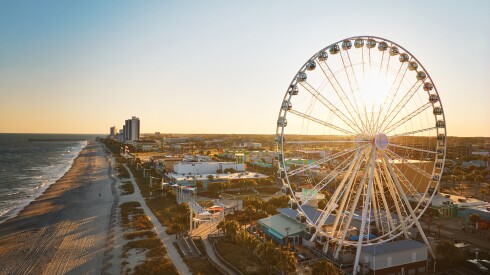With more International Dark Sky Parks than ever before—plus, a whole new Dark Sky Lodging certification—stargazers have plenty of reasons to keep their eyes to the sky this year. While you’ve got the where to go and where to stay covered, we’ve compiled a calendar so you can know exactly when the next meteor shower will be happening in 2024. To help you decide which ones are worth traveling for, we’ve focused this list on the the nine major meteor showers that produce the most active shows each year.
Quadrantids
Peak night: January 3–4, 2024
Though the Quadrantids peaked late at night on January 3 and into the early morning hours of January 4, the remain active until January 16. Under the best conditions, you’ll see an average of 25 meteors per hour during the Quadrantids, making it one of the stronger showers of the year.
Lyrids
Peak night: April 21–22, 2024
Since the Lyrids are only considered to be a medium strength meteor shower and fall on a night when the moon is 96 percent full, it’s probably not worth going out of your way to see it this year. The entire Lyrid meteor shower is active from April 15 to 29, and it is best seen from the Northern Hemisphere. You can also view it from the Southern Hemisphere, but expect lower rates of meteors there.

Capturing photos of meteors is difficult, so just put down that iPhone and enjoy the show.
Photo by Shutterstock
Eta Aquariids
Peak night: May 4–5, 2024
Best seen from the southern tropics, the Eta Aquariids are active between April 15 and May 27. The moon will be 14 percent full on its peak night, making it easier to see these meteors.
Southern Delta Aquariids
Peak night: July 29–30, 2024
Another one best viewed from the southern tropics, the Southern Delta Aquariids are active between July 18 and August 21. The peak night will happen on July 29, when the moon will be 30 percent full, making it slightly easier to see these meteors.

Joshua Tree National Park is one of the best places in the United States to go stargazing.
Photo by Shutterstock
Perseids
Peak night: August 11–12, 2024
While the Perseids are not the strongest shower of the year (that title goes to the Geminids in December), they are the most popular because they fall on warm summer nights. Active between July 14 and September 1, the Perseids will max out the night of August 11. This year, the moon will be 44 percent full on this night, providing somewhat dark skies to see these meteors.
Orionids
Peak night: October 20–21, 2024
In exceptional years, the Orionids can produce up to 75 meteors per hour. But that hasn’t happened since 2009. In a normal year, as 2024 is predicted to be, expect between 10 to 20 meteors per hour. The peak night is October 20, but unfortunately the moon will be 83 percent full then. The entire shower is active between September 26 and November 22.
Leonids
Peak night: November 17–18, 2024
Lasting from November 3 to December 2, the Leonids are known for particularly bright meteors. While the Leonids can produce outbursts of activity in certain years, 2024 is expected to get only about 15 meteors per hour during the shower’s peak on the night of November 17, into the predawn hours of November 18. Also, the moon will be 94 percent full that night, making it very hard to see any meteors.

The Geminid meteor shower seen in Chiang Mai, Thailand
Photo by Shutterstock
Geminids
Peak night: December 13–14, 2024
The Geminids are the strongest meteor shower of the year and can be seen from the northern and southern hemispheres. However, the moon will be 97 percent full on the peak night in 2024, which will spoil the dark sky conditions needed to see most meteors. About 50 meteors per hour are expected during the Geminids each year. The entire shower lasts from November 19 to December 24.
Ursids
Peak night: December 21–22, 2024
The Ursids occur around the same time as the Geminids (December 13 to 24, to be exact). Since the Ursids are only visible from the northern hemisphere and produce just up to 10 meteors per hour, it makes sense that the Geminids get the most attention. Plus, the moon will be 59 percent full on the peak night of December 21, making it a little too bright to see all but the brightest meteors.
Stargazing tips
Remember, light pollution is your enemy. As you start planning trips to catch these celestial shows, be sure to seek out a dark sky place by searching the website of DarkSky International (formerly the International Dark-Sky Association) for locations. It also doesn’t hurt to consult annual weather reports to double-check whether or not you’ll have to contend with cloud cover. Once you’re there, head outside for about 45 minutes before the meteor shower hits its peak so your eyes can adjust to the dark. And don’t forget to bring chairs and blankets to stay comfy and cozy.
This article originally appeared online in 2019; it was updated most recently on January 10, 2024, to include current information.











